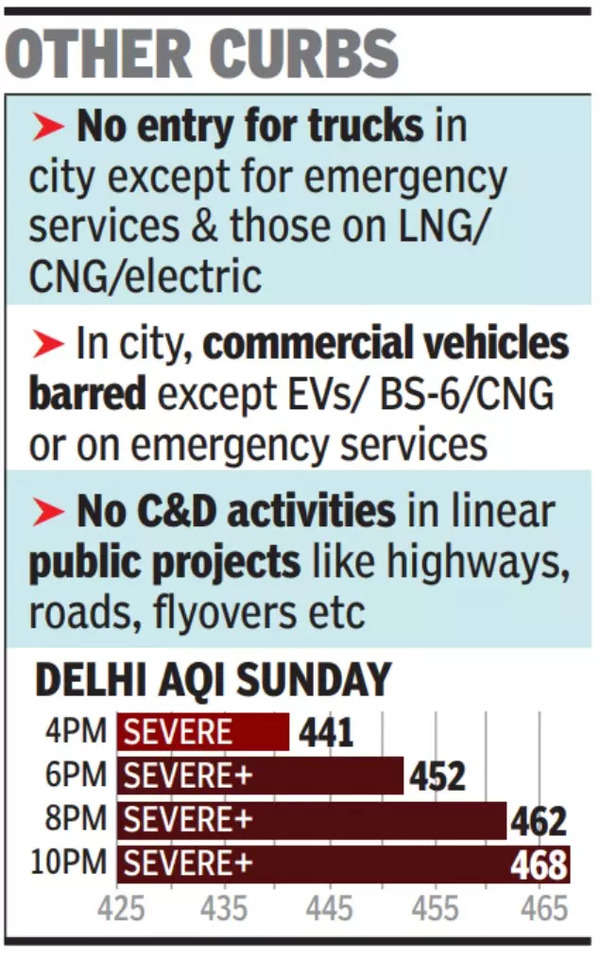NEW DELHI: The toxic haze hanging over NCR for past few days intensified on Sunday and Delhi’s average Air Quality Index deteriorated to the season’s worst of 441 at 4pm, well into the ‘severe’ zone, compared to 419 a day earlier. By 6pm, it had surpassed 450, reaching the ‘severe plus’ category, prompting Commission for Air Quality Management to impose the fourth and most extreme stage of Graded Response Action Plan in NCR from 8am on Monday.
CM Atishi posted: “Physical classes shall be discontinued for all students, apart from Class 10 & 12. All schools will hold online classes till further orders.” Grap-4 also gives an option to central and NCR govts to shift to work-from-home for employees.
Sign of four: GRAP to squeeze Delhi further
GRAP-IV is clamped when the poison in the air reaches “emergency’ levels with AQI surpassing 450 (on a scale of 500). It primarily focuses on vehicular restrictions to reduce pollution. Under stage 4, entry of non-emergency trucks into Delhi has been barred for non-BS 6 compliant light commercial vehicles (LCVs) registered outside Delhi, and BS-4 and below diesel-operated medium and heavy goods vehicles in Delhi. The exemption earlier granted to construction and demolition (C&D) activities in linear public projects such as highways, roads, flyovers, over bridges, power transmission, and pipelines has now been removed.
Central Pollution Control Board’s data shows that the AQI rapidly surged through the day, as visibility remained poor. Delhi’s AQI was 421 at 9am, which spiked to 452 at 6pm and further increased to 468 at 10pm. This was the fourth ‘severe’ day of the month. Before this, the AQI briefly remained in the ‘severe plus’ band on Nov 13 when it went up to 454 at 9pm. However, as CPCB considers the day’s AQI at 4pm, Delhi on Sunday recorded an AQI of 441, the second highest this year after 447 on January 14.
Anumita Roychowdhury, executive director, Research and Advocacy, Centre for Science and Environment (CSE), said, “This is happening because of the combined impact of the deepening of winter inversion and trapping of high local and regional pollution. We need urgent measures to slow down further loading of pollution from the key sources.”

The contribution of stubble burning in Delhi’s PM2.5 stood at 25.2% on Saturday, according to the Decision Support System.
No respite from toxic air is expected in the next few days. “The average AQI for Delhi is expected to remain in the adverse range owing to heavy fog, variable winds, highly unfavourable meteorological and climatic conditions. Forecasts from IMD/llTM indicate a likelihood of the AQI of Delhi to particularly remain in the higher end of the ‘severe’/ ‘severe+’ category in the coming days,” said CAQM.
The measures under GRAP-IV are in addition to the preventive/restrictive actions mentioned under Stage 1 to 3, already in force. Though the ban on construction and demolition activity came into force on Nov 15 under stage 3 of GRAP, linear public projects were included in the exemption. However, the commission on Sunday banned C&D activity in linear public projects.
CAQM said govts in Delhi and NCR to take a decision on allowing public, municipal, and private offices to work at 50% strength and the rest to work from home. Centre govt may take an appropriate decision on permitting work from home for employees in central govt offices. “State govts may consider additional emergency measures like the closure of colleges/educational institutions and closure of non-emergency commercial activities, permitting the running of vehicles on an odd-even basis of registration numbers etc,” said commission in its order.
The Met department said mainly smog conditions with wind speed less than 6kmph from the northwest direction prevailed over the region in the forenoon on Sunday. Winds below 6kmph are unable to disperse pollutants.
The lowest visibility on Sunday was 500 metres at Palam between 8.30am and 9am, while it dipped to 300m at 7am at Safdarjung, which is the city’s base station, according to India Meteorological Department (IMD). Even during the day, with sunlight staying faint, visibility remained low throughout the entire day. A maximum visibility of 900m was recorded at Palam at 5.30 pm and 800 metres at Safdarjung at 2.30 pm.
By 11pm at night, visibility at Palam had dropped precipitously to 150m.
Even the maximum temperature dipped to 27.2 degrees Celsius, one degree below normal. It was the season’s lowest maximum temperature. The minimum temperature stood at 15.9 degrees Celsius, four notches above normal.
IMD has issued an ‘orange’ alert for very dense to dense fog on Sunday night or Monday morning.

